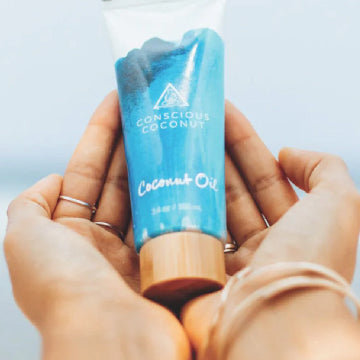Is Fair Trade Beauty Also Clean, Eco-Friendly and Cruelty-Free?

The answer in short, is yes! When explaining what fair trade beauty is, it’s important to reference all the trendy buzzwords associated with beauty these days. Think: clean, green, eco-friendly, vegan, sustainable, and of course, cruelty-free. However, the main difference that fair trade beauty products have going for them is that they also focus on ethical processing and transparent supply chains within their manufacturing practices.
Products that are certified fair trade have been put through a rigorous certification process to ensure that the ingredients used all follow the protocol of fair trade practices. This can be a lengthy and expensive endeavor and frankly, not all brands can afford this level of certification. However, ethical beauty brands that go out of their way to formulate their products with fair trade certified ingredients from a third party and demonstrate adhering to the ethical and responsible rules of fair trade also uplift the beauty industry and infuse it with humanity. When they focus on making sure their ingredient producers are treated fairly and equitably, which includes receiving fair wages in a good working environment, that’s a beauty brand worth paying attention to.

Fair Trade Beauty is Like Slow Fashion
Think of fair trade beauty as similar to slow fashion - the opposite of fast fashion. Fast fashion focuses on quantity versus quality. Zara, a dominating fast fashion powerhouse, goes from spotting trends to stocking storefronts in 30 days. CleanClothes.org found that fast fashion brands create 100 billion clothing pieces a year. Sadly, according to BBC News, out of the 100 billion clothing pieces made per year, 92 million tons of textile waste are created per year. In addition, “the apparel and footwear industries together account for more than 8 percent of global climate impact, greater than all international airline flights and maritime shipping trips combined.” Fast fashion hurts the environment and the people working for them. Garment workers in the fast fashion industry do not receive a living wage. According to the New York Times, garment workers in Bangladesh are paid $37 a month. The Guardian also found that garment workers in Los Angeles, California work “about 60 hours a week with no overtime pay, which results in overall wages at $5 an hour or less." A wage that is "far below California's statewide minimum wage of $14 an hour for companies with more than 26 employees.”
In comparison, slow fashion brands focus on quality versus quantity. With regards to the environment, many slow fashion brands use carbon-neutral production processes. According to Carbon Trust, “a carbon-neutral footprint is one where the sum of the greenhouse gas emissions (CO2e) produced is offset by natural carbon sinks and/or carbon credits.” In addition, slow fashion brands use sustainable materials for their fashion items. For example, many slow fashion brands use deadstock or recycled materials to create new fashion pieces. Slow fashion brands also pay their workers a living wage. Conscious Life and Style blog found that garment workers in India “earned 6,284 rupees ($92) per month on average." "But [the workers] reported that they would have to be making at least 13,000 rupees ($190) — or more than double their actual wages — to cover basic necessities.”

What is Fast Beauty?
Within the beauty realm, many beauty products in traditional retailers are “fast fashion like” because those companies are focused on creating quantity versus quality. Revolution Beauty, like Zara, spots makeup and skincare trends and launches products in record time. BBC News found that Revolution Beauty creates and launches products to market in 16 weeks. However, traditional beauty industry brands can take up to two years to create and launch a product.
Just think about all that product waste. Zero Waste Week found that “more than 120 billion units of packaging are produced globally every year by the cosmetics industry, contributing to the loss of 18 million acres of forest annually.” One of the main practices of fair trade is to Respect the Environment. It’s crucial to focus on the use of raw materials from sustainable managed sources and buying locally where possible.

Beauty Goals: People or Profit?
The big difference between fair trade and ethically sourced beauty versus and “fast” beauty is their end goal. Fair trade products focus on using the beauty world as a vehicle for social change. These brands work directly with communities in various parts of the world where ingredients like shea butter, marula oil, buriti oil and green tea come from. They pay their workers fair wages and give them the support they need to source these ingredients free of exploitation. When you spend your money on a product that is either fair trade certified or formulated with fair trade ingredients, you can feel rest assured that your money is going to toward helping the world be a more beautiful place. In contrast, when you purchase of-the-moment inexpensive products, you’re most likely lining the pockets of companies with questionable labor practices.

Let’s look at Arbor Mundi, a brand sold at Beautyologie. Arbor Mundi’s mission is to “provide valuable natural products from producers committed to integrity including superior quality, sustainable sourcing, and fair trade.” In addition, Arbor Mundi’s brand works to “build a fairer, cleaner and happier global community.” Looking back at Revolution Beauty, the brand aims to “break down barriers that stop people from enjoying beauty – be that price, shade range or accessibility.”
From these two statements alone, customers can see where the brands’ focuses are on. Arbor Mundi focuses on improving Peruvian communities, while Revolution Beauty focuses on creating more products at an affordable price. To continue making strides in the beauty industry for the betterment of people and the planet, sure brands need to be accessible, inclusive and affordable. They also must be ethical and transparent in how they get there.
This article was written by Jane Luu
 Jane L. is the writer behind JulietLyLillyRose, a lifestyle blog about ethical fashion and beauty. Jane shares her love for slow fashion, fair trade beauty, and sustainability through OOTDs, shopping guides, and product reviews. You can find her on Instagram @julietlylillyrose or on Pinterest.
Jane L. is the writer behind JulietLyLillyRose, a lifestyle blog about ethical fashion and beauty. Jane shares her love for slow fashion, fair trade beauty, and sustainability through OOTDs, shopping guides, and product reviews. You can find her on Instagram @julietlylillyrose or on Pinterest.














